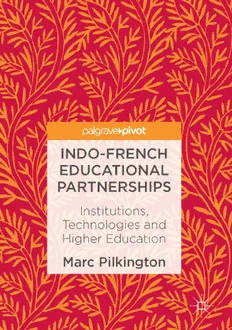
Indo-French Educational Partnerships: Institutions, Technologies and Higher Education PDF
Preview Indo-French Educational Partnerships: Institutions, Technologies and Higher Education
Indo-French Educational Partnerships MarcPilkington Indo-French Educational Partnerships Institutions, Technologies and Higher Education MarcPilkington LEDi,FacultyofLaw,EconomicsandPoliticalScience UniversityofBurgundy Dijon,France ISBN978-1-137-50081-6 ISBN978-1-137-50082-3(eBook) DOI10.1057/978-1-137-50082-3 LibraryofCongressControlNumber:2016957743 ©TheEditor(s)(ifapplicable)andTheAuthor(s)2017 Theauthor(s)has/haveassertedtheirright(s)tobeidentifiedastheauthor(s)ofthisworkin accordancewiththeCopyright,DesignsandPatentsAct1988. This work is subject to copyright. All rights are solely and exclusively licensed by the Publisher,whetherthewholeorpartofthematerialisconcerned,specificallytherightsof translation, reprinting, reuse of illustrations, recitation, broadcasting, reproduction on microfilms or in any other physical way, and transmission or information storage and retrieval,electronicadaptation,computersoftware,orbysimilarordissimilarmethodology nowknownorhereafterdeveloped. Theuseofgeneraldescriptivenames,registerednames,trademarks,servicemarks,etc.inthis publicationdoesnotimply,evenintheabsenceofaspecificstatement,thatsuchnamesare exemptfromtherelevantprotectivelawsandregulationsandthereforefreeforgeneraluse. Thepublisher,theauthorsandtheeditorsaresafetoassumethattheadviceandinformation in this book are believed to be true and accurate at the date of publication. Neither the publishernortheauthorsortheeditorsgiveawarranty,expressorimplied,withrespectto thematerialcontainedhereinorforanyerrorsoromissionsthatmayhavebeenmade. Coverillustration:PatternadaptedfromanIndiancottonprintproducedinthe19thcentury Printedonacid-freepaper ThisPalgravePivotimprintispublishedbySpringerNature TheregisteredcompanyisMacmillanPublishersLtd. Theregisteredcompanyaddressis:TheCampus,4CrinanStreet,London,N19XW, UnitedKingdom P REFACE Whatmakesoursocietiesgrowandprosper?Thisquestionisalmostasold as the field of economics itself. Growth theory morphed into a branch of economicsinitsownrightthroughoutthetwentiethcentury,withmajor economists,suchasSchumpeterandSolow,offeringtheoriesandmodels based on capital accumulation and technological progress. As Greenwald andStiglitz(2014,p.14)note,subsequentattemptsattheprecise quan- tification of the respective roles of the different inputs in growth theory provedextremelydifficult,mainlybecausethe inputsunderscrutinywere intertwined.Theimplementationofnewtechnologiesishencecontingent on the availability of capital equipment, such as new machines, and the respectivecontributionofcapitalaccumulationandtechnologicalprogress toproductivitygrowthisperhapsporous,atleast,notasclear-cutasearly growthmodelsseemed to suggest. This reflection has acquired a qualitative dimension with the introduc- tionofa newelement, namelylearning.Itisanundisputable factthatno matter how these phenomena are explained, quantified or measured, growth and prosperity are also about ‘learning to do things better’ (2014, p. 14). In this sense, one should never understate the conditions (material,economic,intellectualandspiritual)createdbypolicymakers,to promote andenhancethe learning environment oftheir citizens. Notonlyisthepaceoflearning(innovation)themostimportantdetermi- nant of increases in standards of living, the pace itself is almost surely partially, if not largely, endogenous. The speed of progress has differed v vi PREFACE markedlybothovertimeandacrosscountries,andwhilewemaynotbeable toexplainallofthisvariation,itisclearthatgovernmentpolicieshaveplayed arole.Learningisaffectedbytheeconomicandsocialenvironmentandthe structure of the economy, as well as public and private investments in researchandeducation.(2014,p.15) Hernes (2006, p. 3) argues that ‘to provide skilled workers, administra- tors, technicians, engineers, doctors and nurses, indeed, to manage all sectors of the modern economy by applying advanced knowledge, a well-functioning education system is mandatory and higher education has animportant roleto play’. The central nature of knowledge was acknowledged by the OECD as earlyas1996. TheOECDeconomiesareincreasinglybasedonknowledgeandinformation. Knowledge is now recognised as the driver of productivity and economic growth, leading to a new focus on the roleof information, technology and learningineconomicperformance.Theterm‘knowledge-basedeconomy’stems from this fuller recognition of the place of knowledge and technology in modernOECDeconomies.(OECD1996,p.3) This takesus tothe centrallocus ofhigher educationprovision. Auniversityisaplacewherenewideasgerminate,strikerootsandgrowtall and sturdy. Itisa unique space,which covers the entireuniverse ofknowl- edge.Itisaplacewherecreativemindsconverge,interactwitheachotherand constructvisionsofnewrealities.Establishednotionsoftrutharechallenged inthepursuitofknowledge.(YashpalCommitteereport2009,p.9) Beyondtheconfinesofadvancedeconomies,progresshasbeenmadesince the 1990s, with regard tothe fundamental role of emergent economies in thiswide-rangingtransformation,andtheshifttowardsaglobalknowledge- basedeconomy. Inthisnewconfiguration,howdoeconomiesdiffer,orcomplementeach other? How do they diverge or converge? Can potential synergies between learninginstitutions,beyondnationalboundaries,traditionsandcultures,be identifiedexante?Adecisiveeventthatledtothedraftingofthepresentbook wastheopportunityforcollaborativeresearchfundedbytheUniversityGrants PREFACE vii Commission, Delhi, and FMSH, Paris, on ‘International Trade in Higher EducationServicesinaPost-GATSScenario:LearningExperiencesforIndia andFrance’in2008.WewerehostedatthetimebytheresearchunitCNRS- GREDEG,Valbonne,undertheguidanceofProfessorDominiqueTorre. Ajoint-presentationwasgivenatUNESCOinNovember2008.Inthe following years, our Indo-French research cooperation flourished, with severalacademicpaperspublishedinleadinginternationaljournals,suchas International Journal of Education Economics and Development or European Journal of Education. This book is the latest achievement in this ongoing cooperation between France and India. Hopefully, it will benefit academics, students, administrators and policymakers of the two countries,andbeyond. Marc PilkingtonandGeetaNair A CKNOWLEDGEMENTS WewishtothankourcolleaguesatNice,SophiaAntipolisUniversity,who wereactivelyinvolvedinourfirstcollaborativeresearchprojectin2008;our sincere thanks to Dominique Torre, Sylvie Rocchia and Cécile Hagnauer. We are grateful at the institutional level to UGC, Government of India, FMSH, and the coordinators of the Indo-French Fellowship Programme forestablishingthescientificandmaterialconditionsofthisfacultyvisit.We alsothanktheorganizersoftheglobal researchseminarheldatUNESCO in Paris in November 2008 for their kind invitation. Finally, we thank Andrew, Eleanor and Laura at Palgrave Macmillan who showed tremen- douspatience,dedicationandapplicationthroughoutthisproject. Marc PilkingtonandGeetaNair ix C ONTENTS 1 WhyFrance andIndia? The ConvergenceHypothesis 1 1.1 The Cross-Fertilizationof Franceand India’s Intellectual Histories 1 1.2 A Transdisciplinary Outlook 5 1.3 A Triple Knowledge-BasedConvergencebetween theTwo Systems 6 Note 14 2 Education,Growth andDevelopment 15 2.1 The Link BetweenHigher Education andGrowth 16 2.2 The KnowledgeTriangle and theLisbon Strategy 18 2.3 Wither the LisbonStrategy,Welcome Europe 2020 20 2.4 Human Capitaland Economic Development 24 3 TheFrench Higher EducationLandscape 27 3.1 Overview of theFrench Higher EducationSystem 27 3.2 France and theBolognaProcess 29 3.3 Institutional and LegalFeatures ofthe French Higher Education System 31 3.4 A SWOT Analysisofthe French HigherEducation System 49 Notes 56 xi xii CONTENTS 4 TheIndian Scenario 57 4.1 Introduction 58 4.2 Enhancing Access,Excellence andEquity 68 4.3 Internationalization 72 4.4 Ongoing Reformsand Institutional Innovations 77 Notes 85 5 AnIndo-FrenchVirtual University Project 87 5.1 Indo-French Cooperationin Higher Education:Where Do We Stand? 88 5.2 Paving the Way foran Indo-FrenchVirtualUniversity 95 5.3 Conclusion 107 Notes 108 References 111 Index 131
